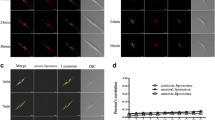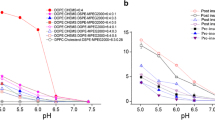Abstract
Purpose. Drug carriers such as liposomes may enhance the intracellular delivery of therapeutic agents for infectious or neoplastic diseases. However, the mechanisms affecting cellular retention of liposome contents are understood poorly. We tested the hypothesis that retention of anionic compounds may be modulated by a nonspecific probenecid-sensitive anion transport mechanism, and that liposome composition may determine the impact of such transporters on drug retention by cells.
Methods. The fluorescent anionic dye hydroxy-pyrene-[ 1,3,6]-trisulfonate (HPTS) was transferred to the cytoplasm of cultured CV-1 or J774 cells by direct needle-microinjection or by ATP-induced permeabilization of the plasma membrane, respectively, to investigate whether the cells have anion transport mechanisms capable of extruding HPTS from the cytoplasm. Cellular retention of dye was monitored in the presence and absence of the anion transport inhibitors probenecid or sulfinpyrazone. Liposomes containing HPTS were co-labeled with tetramethylrhodamine-labeled phosphatidylethanolamine (Rho-PE) as a marker of liposome membrane fate, and uptake was investigated using J774 cells.
Results. Needle-injected HPTS underwent both sequestration in early endocytic vesicles and rapid extrusion into the extracellular medium. Probenecid or sulfinpyrazone reduced the extrusion of HPTS. Thus HPTS is a substrate for a probenecid-sensitive anion transporter in J774 and CV1 cells. After delivery via fluid liposomes composed of phosphatidylglycerol: phosphatidylcholine: cholesterol (3:7:5 mole ratio) and co-labeled with Rho-PE, cell-associated HPTS declined more rapidly than did Rho-PE. Exposure of cells to 5 mM probenecid doubled the quantity of HPTS retained by cells, without changing the retention of the Rho-PE membrane marker. In contrast, the effect of probenecid was negligible when gel-phase liposomes of distearoylphosphatidyl-glycerol:cholesterol (10:5 mole ratio) were used.
Conclusions. Probenecid-sensitive nonspecific anion transporters can mediate the extrusion of model anions delivered via liposomes. However, liposome composition modulates the amount of material subject to extrusion from cells, possibly by altering the endocytic compartment in which liposomes release their contents.
Similar content being viewed by others
REFERENCES
K. D. Lee, K. Hong, and D. Papahadjopoulos. Biochim. Biophys. Acta 1103:185–197 (1992).
K.-D. Lee, K. Hong, S. Nir, and D. Papahadjopoulos. Biochemistry 32:889–899 (1993).
R. Straubinger, K. Hong, D. Friend, and D. Papahadjopoulos. Cell 32:1069–1079 (1983).
R. Straubinger, D. Papahadjopoulos, and K. Hong. Biochemistry 29:4929–4939 (1990).
D. L. Daleke, K. Hong, and D. Papahadjopoulos. Biochim. Biophys. Acta 1024:352–366 (1990).
T. H. Steinberg, A. S. Newman, J. A. Swanson, and S. C. Silverstein. J. Cell Biol. 105:2695–2702 (1987).
B. Lipman, S. Silverstein, and T. Steinberg. J. Biol. Chem. 265:2142–2147 (1990).
C. Cao, S. Silverstein, H. Neu, and T. Steinberg. J. Infect. Disease 165:322–328 (1992).
T. H. Steinberg, J. A. Swanson, and S. C. Silverstein. J. Cell Biol. 107:887–896 (1988).
K. Kano and J. H. Fendler. Biochim. Biophys. Acta 509:289–299 (1978).
K. A. Giuliano and R. J. Gillies. Anal. Biochem. 167:362–371 (1987).
Y.-K. Oh and R. M. Straubinger. Infect. Immun. 64:319–325 (1996).
Y.-K. Oh, D. E. Nix, and R. M. Straubinger. Antimicrob. Agents Chemother. 39:2104–2111 (1995).
Y.-K. Oh and R. M. Straubinger. J. Liposome Res. 7:101–114 (1997).
F. Olson, C. A. Hunt, F. C. Szoka Jr., W. J. Vail, and D. Papahadjopoulos. Biochim. Biophys. Acta 557:9–23 (1979).
R. Fraley, R. M. Straubinger, G. Rule, E. L. Springer, and D. Papahadjopoulos. Biochemistry 20:6978–6987 (1981).
D. Chin, G. Green, G. Zon, F. Szoka, and R. Straubinger. New Biologist 2:1091–1100 (1990).
D. Chin, R. Straubinger, S. Acton, I. Näthke, and F. Brodsky. Proc. Natl. Acad. Sci. USA 86:9289–9293 (1989).
T. H. Steinberg, A. S. Newman, J. A. Swanson, and S. C. Silverstein. J. Biol. Chem. 262:8884–8888 (1987).
T. D. Heath and C. S. Brown. J. Liposome Res. 1:303–317 (1989).
A. Sharma, N. L. Straubinger, and R. M. Straubinger. Pharm. Res. 10:1434–1441 (1993).
G. Lopez-Berestein. Antimicrob. Agents Chemother. 31:675–678 (1987).
P. Couvreur, E. Fattal, and A. Andremont. Pharm Res. 8:1079–1086 (1991).
S. Majumdar, D. Flasher, D. Friend, P. Nassos, D. Yajko, W. K. Hadley, and N. Düzgünes. Antimicrob. Agents Chemother. 36:2808–2815 (1992).
E. Fattal, J. Rojas, M. Youssef, P. Couvreur, and A. Andremont. Antimicrob. Agents Chemother. 35:770–772 (1991).
M. Magallanes, J. Dijkstra, and J. Fierer. Antimicrob. Agents Chemother. 37:2293–2297 (1993).
Author information
Authors and Affiliations
Corresponding author
Rights and permissions
About this article
Cite this article
Oh, YK., Straubinger, R.M. Cellular Retention of Liposome-Delivered Anionic Compounds Modulated by a Probenecid-Sensitive Anion Transporter. Pharm Res 14, 1203–1209 (1997). https://doi.org/10.1023/A:1012158924547
Issue Date:
DOI: https://doi.org/10.1023/A:1012158924547




